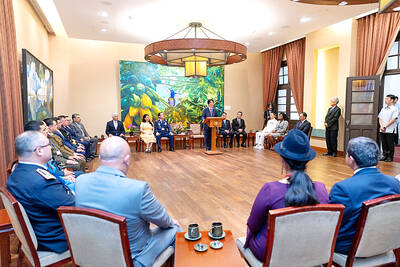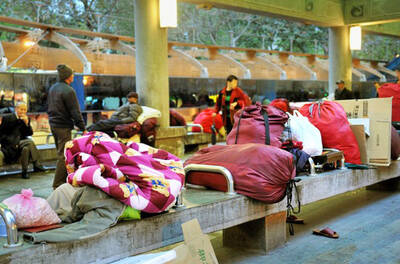Lin Chiu-an (林秋安) is a rising Taiwanese bonsai artist. He said that growing bonsai has became a popular art form throughout the world and that everyone could enrich their lives by owning bonsai trees and learning the basic knowledge required to take care of them.
Lin, who has a bonsai garden at Songheryuan Bonsai Park (松和園) in Wufeng (霧峰) District, Greater Taichung, has created a number of bonsai trees which have been displayed in bonsai exhibitions and entered into competitions around the nation.
“I do not think bonsai art is a Chinese-style or Asian-style art form … It is an art of the world because bonsai simulates trees in miniature and displays nature, which is to be loved and appreciated universally,” Lin said.
“To me the joy of cultivating bonsai trees is watching them develop and the way they change over the four seasons — buds open in spring, trees are lush and green in summer, leaves turn red and fall in autumn and the bare branches are beautiful in winter. Some species also grow fruits which I find most enjoyable,” he added.
The cultivation of bonsai requires patience, Lin said.
“Changes occur gradually. A normal tree will slowly change its shape year by year after periodic pruning. Slowly, the trunk and branches will grow into a beautiful tree,” Lin added. “This is why bonsai is called ‘living art.’”
Taiwan and Japan are the best in the world at bonsai art, but bonsai is becoming increasingly popular around the world. Bonsai associations and clubs are now booming in the Western world, Lin said.
Taiwanese bonsai cultivators have formed relationships with foreign bonsai lovers through international bonsai associations and we expect more communication and trading, Lin added.
People can enjoy owning their own bonsai trees with a basic knowledge of how to take care of plants — buying the trees, watering them properly, creating a good environment for photosynthesis to take place and preventing blight.
However, if people want to create bonsai artworks themselves, they must learn the basic skills and methods used, and the best way to do this is by attending bonsai classes, Lin added.
Lin has encouraged bonsai lovers go to the mountains to observe the shapes of different tree species in Taiwan.
“Juniper is grown at high altitudes. Affected by the violent geography and climate, it always develops a flexible trunk and branches. Their trunks are twisted and their leaves are shaped like needles. They are one of the most beautiful trees on the planet,” Lin said.
Along the road from Chingjing Farm to Hehuan Mountain (合歡山), Taiwan white fir and Taiwan red pine can be found, which display incredible shapes, Lin added.
The value of a bonsai tree depends on its age and how well it imitates nature. When choosing a tree it is important to avoid trees that look too artificial, Lin said.
Bonsai growers in Taiwan are lucky because of the temperate climate. The subtropical environment allows trees to grow faster and for longer, while the varied temperatures found in mountainous areas create a greater range of tree species.
Bonsai could become a creative cultural industry which could fuel Taiwan’s economy, Lin said.
The nation’s banyan and juniper bonsai are very popular around the world and are exported to Southeast Asia, China and the West because they suit most environments worldwide.
However, other bonsai species found in Taiwan, such as the jasmine orange which grows in Hengchun Peninsula (恆春半島), Pingtung County and the Taiwan white pine which grows along the valleys of the Dajia River (大甲溪) in Greater Taichung, would not suit climates outside of Taiwan, he added.

Costa Rica sent a group of intelligence officials to Taiwan for a short-term training program, the first time the Central American country has done so since the countries ended official diplomatic relations in 2007, a Costa Rican media outlet reported last week. Five officials from the Costa Rican Directorate of Intelligence and Security last month spent 23 days in Taipei undergoing a series of training sessions focused on national security, La Nacion reported on Friday, quoting unnamed sources. The Costa Rican government has not confirmed the report. The Chinese embassy in Costa Rica protested the news, saying in a statement issued the same

Taiwan’s Liu Ming-i, right, who also goes by the name Ray Liu, poses with a Chinese Taipei flag after winning the gold medal in the men’s physique 170cm competition at the International Fitness and Bodybuilding Federation Asian Championship in Ajman, United Arab Emirates, yesterday.

A year-long renovation of Taipei’s Bangka Park (艋舺公園) began yesterday, as city workers fenced off the site and cleared out belongings left by homeless residents who had been living there. Despite protests from displaced residents, a city official defended the government’s relocation efforts, saying transitional housing has been offered. The renovation of the park in Taipei’s Wanhua District (萬華), near Longshan Temple (龍山寺), began at 9am yesterday, as about 20 homeless people packed their belongings and left after being asked to move by city personnel. Among them was a 90-year-old woman surnamed Wang (王), who last week said that she had no plans

TO BE APPEALED: The environment ministry said coal reduction goals had to be reached within two months, which was against the principle of legitimate expectation The Taipei High Administrative Court on Thursday ruled in favor of the Taichung Environmental Protection Bureau in its administrative litigation against the Ministry of Environment for the rescission of a NT$18 million fine (US$609,570) imposed by the bureau on the Taichung Power Plant in 2019 for alleged excess coal power generation. The bureau in November 2019 revised what it said was a “slip of the pen” in the text of the operating permit granted to the plant — which is run by Taiwan Power Co (Taipower) — in October 2017. The permit originally read: “reduce coal use by 40 percent from Jan.